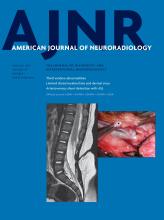Index by author
Potts, M.B.
- EDITOR'S CHOICEINTERVENTIONALOpen AccessEmergent Endovascular Management of Long-Segment and Flow-Limiting Carotid Artery Dissections in Acute Ischemic Stroke Intervention with Multiple Tandem StentsS.A. Ansari, A.L. Kühn, A.R. Honarmand, M. Khan, M.C. Hurley, M.B. Potts, B.S. Jahromi, A. Shaibani, M.J. Gounis, A.K. Wakhloo and A.S. PuriAmerican Journal of Neuroradiology January 2017, 38 (1) 97-104; DOI: https://doi.org/10.3174/ajnr.A4965
The authors investigated the role of emergent endovascular stenting of long-segment carotid dissections in the acute ischemic stroke setting in 15 patients. They specifically evaluated long-segment carotid dissections requiring stent reconstruction with multiple tandem stents (≥ 3 stents) and presenting with acute (<12 hours) ischemic stroke symptoms (NIHSS score, ≥ 4). Carotid stent reconstruction was successful in all patients with no residual stenosis or flow limitation. Nine patients (60%) harbored intracranial occlusions, and 6 patients (40%) required intra-arterial thrombolysis/thrombectomy, achieving 100% TICI 2b–3 reperfusion. They conclude that emergent stent reconstruction of long-segment and flow-limiting carotid dissections in acute ischemic stroke intervention is safe and effective, with favorable clinical outcomes.
Poussaint, T. Young
- PEDIATRICSYou have accessAutomated Processing of Dynamic Contrast-Enhanced MRI: Correlation of Advanced Pharmacokinetic Metrics with Tumor Grade in Pediatric Brain TumorsS. Vajapeyam, C. Stamoulis, K. Ricci, M. Kieran and T. Young PoussaintAmerican Journal of Neuroradiology January 2017, 38 (1) 170-175; DOI: https://doi.org/10.3174/ajnr.A4949
Prater, A.
- ADULT BRAINYou have accessBody Temperature Modulates Infarction Growth following Endovascular ReperfusionS. Dehkharghani, M. Bowen, D.C. Haussen, T. Gleason, A. Prater, Q. Cai, J. Kang and R.G. NogueiraAmerican Journal of Neuroradiology January 2017, 38 (1) 46-51; DOI: https://doi.org/10.3174/ajnr.A4969
Preda, C.
- INTERVENTIONALYou have accessImpact of Modified TICI 3 versus Modified TICI 2b Reperfusion Score to Predict Good Outcome following Endovascular TherapyC. Dargazanli, A. Consoli, M. Barral, J. Labreuche, H. Redjem, G. Ciccio, S. Smajda, J.P. Desilles, G. Taylor, C. Preda, O. Coskun, G. Rodesch, M. Piotin, R. Blanc and B. LapergueAmerican Journal of Neuroradiology January 2017, 38 (1) 90-96; DOI: https://doi.org/10.3174/ajnr.A4968
Pruvo, J.-P.
- FELLOWS' JOURNAL CLUBADULT BRAINYou have accessIntracranial Arteriovenous Shunting: Detection with Arterial Spin-Labeling and Susceptibility-Weighted Imaging CombinedJ. Hodel, X. Leclerc, E. Kalsoum, M. Zuber, R. Tamazyan, M.A. Benadjaoud, J.-P. Pruvo, M. Piotin, H. Baharvahdat, M. Zins and R. BlancAmerican Journal of Neuroradiology January 2017, 38 (1) 71-76; DOI: https://doi.org/10.3174/ajnr.A4961
Ninety-two consecutive patients with a known (n = 24) or suspected arteriovenous shunting (n = 68) underwent DSA and brain MR imaging, including arterial spin-labeling/SWI and conventional angiographic MR imaging. DSA showed arteriovenous shunting in 63 of the 92 patients. Interobserver agreement was excellent. In 5 patients, arterial spin-labeling/SWI correctly detected arteriovenous shunting, while the conventional angiographic MR imaging did not. The authors conclude that the combined use of arterial spin-labeling and SWI may be an alternative to contrast-enhanced MRA for the detection of intracranial arteriovenous shunting.
Puri, A.S.
- EDITOR'S CHOICEINTERVENTIONALOpen AccessEmergent Endovascular Management of Long-Segment and Flow-Limiting Carotid Artery Dissections in Acute Ischemic Stroke Intervention with Multiple Tandem StentsS.A. Ansari, A.L. Kühn, A.R. Honarmand, M. Khan, M.C. Hurley, M.B. Potts, B.S. Jahromi, A. Shaibani, M.J. Gounis, A.K. Wakhloo and A.S. PuriAmerican Journal of Neuroradiology January 2017, 38 (1) 97-104; DOI: https://doi.org/10.3174/ajnr.A4965
The authors investigated the role of emergent endovascular stenting of long-segment carotid dissections in the acute ischemic stroke setting in 15 patients. They specifically evaluated long-segment carotid dissections requiring stent reconstruction with multiple tandem stents (≥ 3 stents) and presenting with acute (<12 hours) ischemic stroke symptoms (NIHSS score, ≥ 4). Carotid stent reconstruction was successful in all patients with no residual stenosis or flow limitation. Nine patients (60%) harbored intracranial occlusions, and 6 patients (40%) required intra-arterial thrombolysis/thrombectomy, achieving 100% TICI 2b–3 reperfusion. They conclude that emergent stent reconstruction of long-segment and flow-limiting carotid dissections in acute ischemic stroke intervention is safe and effective, with favorable clinical outcomes.
Qiu, D.
- FUNCTIONALYou have accessThe Effects of Acetazolamide on the Evaluation of Cerebral Hemodynamics and Functional Connectivity Using Blood Oxygen Level–Dependent MR Imaging in Patients with Chronic Steno-Occlusive Disease of the Anterior CirculationJ. Wu, S. Dehkharghani, F. Nahab, J. Allen and D. QiuAmerican Journal of Neuroradiology January 2017, 38 (1) 139-145; DOI: https://doi.org/10.3174/ajnr.A4973
Quilici, L.
- INTERVENTIONALYou have accessEmbolization of Intracranial Dural Arteriovenous Fistulas Using PHIL Liquid Embolic Agent in 26 Patients: A Multicenter StudyS. Lamin, H.S. Chew, S. Chavda, A. Thomas, M. Piano, L. Quilici, G. Pero, M. Holtmannspolter, M.E. Cronqvist, A. Casasco, L. Guimaraens, L. Paul, A. Gil Garcia, A. Aleu and R. ChapotAmerican Journal of Neuroradiology January 2017, 38 (1) 127-131; DOI: https://doi.org/10.3174/ajnr.A5037
Quivey, J.M.
- HEAD & NECKYou have accessImpact of Neuroradiology-Based Peer Review on Head and Neck Radiotherapy Target DelineationS. Braunstein, C.M. Glastonbury, J. Chen, J.M. Quivey and S.S. YomAmerican Journal of Neuroradiology January 2017, 38 (1) 146-153; DOI: https://doi.org/10.3174/ajnr.A4963
Rammos, S.K.
- You have accessReply:S.K. Rammos, C. Bortolotti and G. LanzinoAmerican Journal of Neuroradiology January 2017, 38 (1) E5; DOI: https://doi.org/10.3174/ajnr.A4988








